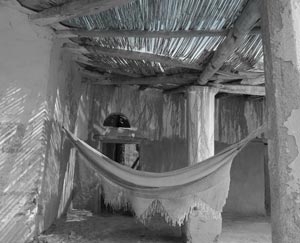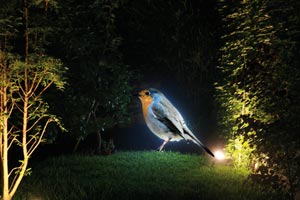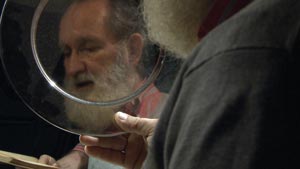Interested in the complex relation betweenParaguayans and Argentineans –pervaded by hindrances from the Triple Alliance war (1864-1870), dictatorial complicity (Condor plan), border tensions and conflicts related to illegal migrants–, curator Victoria Verlichak gathered in one exhibition, titled Paraguay rapé (Camino paraguayo), Argentineans of Paraguayan ancestry Matilde Marin and Luna Paiva, and Paraguayans Joaquin Sanchezand Angel Yegros. The exhibition kicked off some months ago at Recoleta Cultural Center, Buenos Aires, as part of the celebrations for the Bicentenary.
 These artworks mention true situations or characters, but they are all about personal experiences on the verge of the official story. They leave deep scars, evoke silence zones, interior moors, fictions enriched by time. The brief and intense exhibition articulates, with accuracy and elegance, four proposals that give Argentinean viewers an against-the-grain vision of Paraguay as stacked up against the widespread stereotype used to identify Paraguayans in the neighbor country.
These artworks mention true situations or characters, but they are all about personal experiences on the verge of the official story. They leave deep scars, evoke silence zones, interior moors, fictions enriched by time. The brief and intense exhibition articulates, with accuracy and elegance, four proposals that give Argentinean viewers an against-the-grain vision of Paraguay as stacked up against the widespread stereotype used to identify Paraguayans in the neighbor country.
Suite Villarrica
Matilde Marin, Alejandro Marin Iglesias’s niece (who was a minister with President Jose Felix Estigarribia), finds his Paraguayan ancestry in the old house of his grandparents in Villarrica, famous city due to its love of arts and letters. Through family testimonies, plenty of pain and nostalgia, he learned myths about the country, the splendor of nature, Chaco war and political turbulences that forced his father to live in exile, just like many other Paraguayans who settled down in Buenos Aires. So, he grew up with the sensation of a lost world and notes that will come to the surface on his work. Character Saturio Rios stands out in Paraguayan mythology, one of the young scholars sent by Carlos Antonio Lopez to Europe in 1858, who would become famous due to his artistic talent and participation as one of the engravers of Cabichui, trench newspaper published in 1867 and 1868, celebrated for its satirical illustrations that were made on xylograph. In Marin’s installation, who mastered the engraving art, personal identity is configured out of superimposed images, merged fragments, signs from a mayor story. In an austere layered showcase, historical pictures are shown along with newspaper cuttings, prints and postcards, within a cartography that evidences the different nature of memories, their dissimilar material, their erratic order.
Yukyty (Campos de sal)
“Their own mothers painted mustaches with charcoal. They made beards out of horse manes…”, first phrase on Joaquin Sanchez’s video, whose title already provides the key and extraordinarily renders the yearning for overcoming past traumas. “Salt heals and brine preserves”, the artist reflects. The images, of exquisite and tragic beauty, attract the immediate attention of people entering the hall. An old washerwoman recalls, with the sound of flowing water, the massacre of Acosta Ñu. The episode is remembered as one of the crucial moments during the war, when some 3 500 children, dressed like soldiers, died fighting almost 20 000 men from the allied army. The video has been recorded in the site where the events took place, almost a magical action. Nothing is casual: this has been the ground of the artist’s child games (familiar field), the place of threat, cursed spot where the sun reveals ghosts: “The grand war kicked off during a hot day just like today” words ending the story, opening it to memories. Beyond the episode –which practically put an end to the Triple Alliance war–, the refined visualization of this work moves over historical references and each element acquires the strength and intensity of a symbol. With delicateness, it exposes human condition with total roughness, questioning fundaments of the so called “love for the homeland.”
 Paiva Paraná Paiva
Paiva Paraná Paiva
This artwork took Luna Paiva –daughter of the acclaimed photographer Roland Paiva and former President Felix Paiva’s great-granddaughter niece– to revisit her father’s world. He creates, with images taken during the long upstream trip, along Parana river –which were put together in a memorable book published in the 1990s– a video with fictional atmosphere that dialogues with heavenly tridimensional sceneries and luminous diorama “where color prevails and nature reigns: more real than life, but also oneiric and timeless […] inhabited by lush vegetation and stunned tones [that] sweep any expression of nostalgia”, according to Verlichak. The curator says that “expatriate, Luna’s grandparents of her father’s branch fought as members of the International Brigades against Francisco Franco and joined French Resistance against Nazis during World War 2. Her grandfather, Emiliano Paiva, communist militant, was executed when Rolando was still a child”. Up to now, Luna Paiva feels Paraguay as a mythical world to be explored, with emotional ties, beyond bitterness. The title itself installs the nexus between both generations, linked by the river flow.
 Tekoha (el lugar del ser)
Tekoha (el lugar del ser)
Reintroducing the name of a recent individual exhibition, Angel Yegros tackles Paraguayan history from his own genealogy, as he refers, in visual metaphor, Guarani substratum. The video begins with a gesture of erasure of the original universe, to advance toward an introspective moment that exposes Fulgencio Yegros’s profound deception, national hero of Independence. Away from ingenuous evocation, the work sets an atmosphere of deep reflection. The historical character emerges on a dusty surface that reflects the artist’s face, brought to the present by blood and memory. In front of this improvised mirror that’s superimposed to other mirror, “real”, in a game of infinite illusions, Angel Yegros reads the poem written by his grandfather Fulgencio in jail, before his execution ordered by dictator Gaspar Rodriguez from France. Simultaneously, family maps go by, accurate guides to establish affiliation and fidelity to a story scavenged by successive versions of history. The obsessive reiteration of an anonymous Guarani poem, taken by poet Oscar Ferreiro, some decades ago, acts as repairing litany that rebalances the world. Yegros’s famous text “I spent all these years planting hope and an impossible flowered with fruits of disappointment […]”, is counterpointed by a chant to creation, beauty, land and its fruits: “Che ruvusu, che ruvusu, yvy o mbojegua ara ka’e, itymbyra ra poky, rory rory […]”. Happiness, happiness.
Related Publications

How Harumi Yamaguchi invented the modern woman in Japan
March 16, 2022












